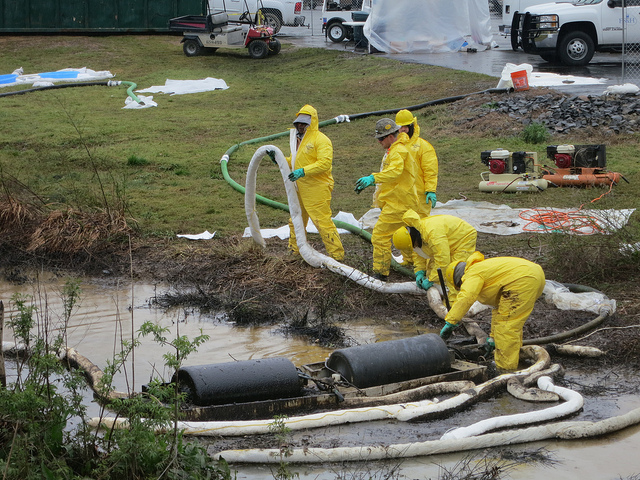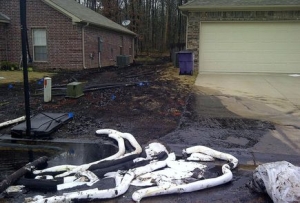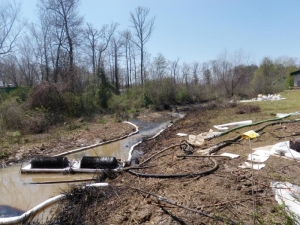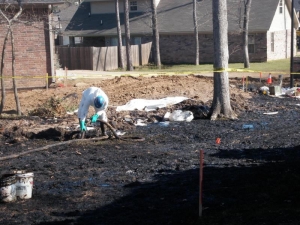On March 29, 2013, the ExxonMobil Pegasus pipeline ruptured in a residential subdivision in Mayflower, Arkansas, about 20 miles northwest of Little Rock. Approximately 3,190 barrels (134,000 gallons) of oil spilled down a residential street and into storm drains, flowing into nearby waterways, including an unnamed creek, wetlands, and a cove of Lake Conway. Twenty-two homes were evacuated. The U.S. Environmental Protection Agency (EPA) classified the event as a major spill.
Before the 2013 Mayflower oil spill, the Pegasus pipeline carried 95,000 barrels per day of crude roughly 859 miles from Patoka, Illinois to Nederland, Texas. The pipeline was 20 inches in diameter and buried an average of 24 inches below ground.
The Pegasus pipeline was carrying Wabasca Heavy crude from the Athabasca tar sands in Alberta, Canada. Wabasca Heavy crude is a thick, tarry substance often classified as a bitumen that must be diluted with lighter hydrocarbons referred to as diluents before being transported. The Wabasca Heavy crude diluents typically include liquid natural gas, benzene, hydrogen sulfide, and other hazardous substances. That means the oil that spilled in Mayflower is very similar to the diluted bitumen or dilbit that spilled into the Kalamazoo River during the 2010 Enbridge oil spill.
The Pegasus pipeline failed with a 22-foot gash along the seam line. A review ordered as part of the U.S. Pipeline and Hazardous Materials Safety Administration (PHMSA) investigation revealed that the failure was likely caused by an original manufacturing defect. The 648-mile northern segment of the Pegasus pipeline, which carried dilbit from Illinois to Corsicana, Texas, was built in the late 1940s using low-frequency electric-resistance welded (ERW) pipe. ERW pipe built before the 1970s is known to have manufacturing flaws and be susceptible to splitting along its lengthwise seams. The operator had inaccurately determined that the pipeline was not susceptible to seam failures and had not adequately assessed the pipeline for problems.
Exxon stated that approximately 12,000 barrels of oil mixed with water had been recovered by March 31, but the company was unable to determine how much of the mixture was oil. The company removed and repaired the section of pipeline that ruptured and stated that they are committed to cleaning up the affected land and waterways pursuant to Arkansas Department of Environmental Quality (ADEQ) oversight.
In June 2013, the United States of America, on behalf of the EPA, and the State of Arkansas, on behalf of ADEQ, filed a lawsuit against ExxonMobil Pipeline Company (EMPCo) for violations of the Clean Water Act and Arkansas State law. On August 12, 2015, U.S. District Judge Kristine Baker approved the consent decree negotiated by the parties. The settlement specifies that EMPCo will pay $3.19 million plus interest to the U.S. government and $1.88 million to the state of Arkansas. The agreement also requires Exxon to adjust some of its testing, maintenance, and operating procedures for the northern segment of the Pegasus pipeline. However, the consent decree did not require EMPCo to admit liability, and many critics, particularly local water utilities such as Central Arkansas Water, have complained that it does not do enough to protect drinking water sources near the aging pipeline.
On October 1, 2015, PHMSA issued its Final Order in the case, determining that Exxon had committed nine violations of pipeline safety regulations. PHMSA also noted 12 prior offenses in the 5 years previous to the Mayflower incident. Accordingly, EMPCo was assessed a civil penalty of $2,630,400. PHMSA also issued a Compliance Order requiring EMPCo to change how it tests and maintains all ERW pipe built before the 1970s. On October 21, EMPCo petitioned for reconsideration of the penalty and filed a motion to stay the Compliance Order, claiming that roughly a quarter of all liquid pipeline in the United States consists of pre-1970 ERW pipe. The company was granted a 90-day stay for both the penalty and the compliance order while PHMSA reviews the petition.
However, neither the settlement with the federal and state governments nor the penalty assessed by PHMSA compensates the residents affected by the spill. By Exxon’s own estimate, the spill caused $57.5 million in property damage and forced 22 families to evacuate. More than 130 property owners in the affected area have filed lawsuits to recover damages. Most of those suits were consolidated, and an initial trial was scheduled for October 20, 2015 in Faulkner County Circuit Court.
Other property owners along the Pegasus pipeline are concerned about the possibility of future spills. As such, they have filed a class action lawsuit, asking that the easement be canceled or the pipeline removed or replaced. U.S. District Judge Brian Miller certified the class in August 2014, then reversed his decision in March 2015, dismissing the lawsuit with prejudice and decertifying the class. Judge Miller agreed with EMPCo’s argument that Arkansas law views easement contracts “as the mere granting of a right of way, without any affirmative duty to maintain or repair.” That leaves easement grantors unable to take action until after their property has actually been harmed. The plaintiffs’ attorneys have filed an appeal asking the 8th U.S. Circuit Court of Appeals in St. Louis to reverse Judge Miller’s ruling.
As of October 2015, EMPCo claimed to have spent more than $75 million in response to the incident, and several lawsuits, civil penalties, and damage claims are still unresolved. We’ll post updates when we learn more.









Recent Comments